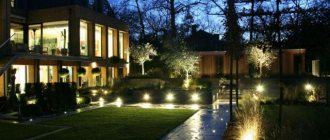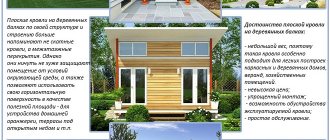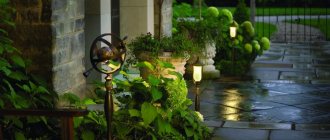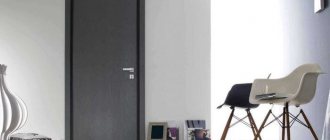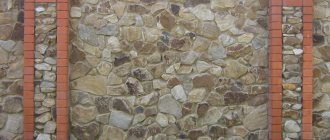Purpose of architectural lighting
Architectural lighting allows you to highlight the silhouettes of buildings and give them a presentable appearance. With its help you can decorate minor flaws. An original lighting solution also has marketing significance: for commercial objects it ensures that images are memorable and increases interest in them from visitors or buyers. In general, when implementing architectural lighting, two approaches can be distinguished:
- Creation of a specific night counter-image of buildings that has no analogues in natural light. This solution is often used for commercial properties.
- Maximum preservation of the external appearance of buildings. This is relevant for buildings of historical value.
Professional facade lighting
The penumbra and shadows that fall on the walls, the play of subtle shades and dazzling lights, like golden fireflies - all this is truly created by man. Architectural lighting is something new, something that can give a building an amazing appearance, thereby emphasizing all the original details. Needless to say, it is precisely because of this light and the talent of lighting designers that we can admire beautiful buildings even in the dark. Special lighting will help make your house stand out from the rest. External lighting of a building implies:
- beautiful architectural light and various illuminations;
- universal LED lighting;
- modern neon lighting.
Professionally created architectural lighting highlights the outlines and edges of the building, gives it more romance or, conversely, emphasizes the business look and image.
A lighting designer can improve a building in the following ways:
- Create architectural lighting that will give the building and street a festive atmosphere.
- Beautifully decorate any home.
- Highlight a bright accent on the most beautiful and worthy parts of the house.
Possible building lighting
There are several methods for illuminating the facade of a building:
- General flood lighting of an area is the most popular and in demand method. It includes static lighting of a plane or a three-dimensional object, which makes the facade perfectly visible in the evening and at night.
- Local method - helps to emphasize the main details of monuments and facades, concentrates a person’s attention on the historical and artistic details of the structure.
- Silhouette lighting of a building - helps to create a certain contrast between a darkened part of a building and a light facade by projecting a beam of light from the background. Lighting designers also use a special light background to darken the overall silhouette of the building.
- Contour lighting is another method by which a lighting designer can develop a beautiful lighting design for the façade of a building. This method involves creating contrast between niches and walls, as well as the edges of the building.
- Carrying out dynamic lighting - helps to enhance the overall flooding effect by using different degrees of illumination on individual parts of the building. Dynamic backlight can also change its color and brightness.
- A lighted façade is a simple method that provides the traditional aesthetics of a glazed building using equipment installed inside it. Smooth, single-color lighting is used to illuminate commercial and office buildings.
To create an expressive light appearance of a building, it is imperative to take into account the area of the object, its location in relation to other architectural buildings, the style of decoration, texture and many other important parameters.
Areas of use
Most often, architectural lighting is created for buildings such as:
- Country plots and private houses, small hotel houses.
- City buildings. These can be architectural monuments, offices of large stores, administrative buildings, shopping centers.
- Bridges.
The lighting method is selected depending on the purpose of the building, its location and architectural characteristics.
Types of architectural lighting
There are several most popular types of architectural lighting:
- General flood is used to provide a holistic perception of large objects. Implemented using powerful spotlights.
- Local-zonal allows you to highlight certain elements of objects: columns, bas-reliefs, window openings, etc. In this case, accent spotlights of low and medium power are used.
- Illuminated facades are in demand when lighting buildings with glass facades: administrative, shopping or entertainment centers. In this case, the lamps are placed indoors.
- Background silhouette lighting is used to highlight the outlines of buildings. This is achieved by installing spotlights on the back of objects.
- Contour is used to highlight geometric shapes or elements of buildings. In this case, linear lamps are used.
- Color-dynamic combines several effects. It involves changing the color, contrast and intensity of light fluxes. In this case, a combination of lamps and spotlights of various types is used.
Types of facade lighting of buildings
Contour architectural lighting of the house
LED strips or flexible neon are typical elements for creating contour architectural lighting for a building. With this method of lighting design, building elements are emphasized along the contours of windows, roofs, ceilings, columns or balconies, entrance steps, creating a unique and attractive appearance of the house and emphasizing all the advantages of its architecture, but it must be taken into account that not all architectural solutions are suitable for contour lighting. Often contour lighting is used to give an attractive look to construction projects and decorates tower cranes. Options for the color scheme can be monochromatic classic colors, multi-colored (RGB) LED strips or duralight with light-dynamic effects, which can change color according to a given algorithm, the system operates from a stationary button or from a remote control. Such a contour lighting solution will make the house stand out against the background of other buildings and will undoubtedly attract people's attention.
The example shows the illumination of the facade of a multi-storey residential building, performed by Garant Media
The main task solved by contour lighting at home is:
- creating an expressive outline of the facade,
- emphasizing its edges without emphasizing individual architectural elements,
- visual scaling.
The use of duralight or neon cord (flexible neon) will create the effect of a soft, sophisticated glow, and in combination with other lighting elements this effect can be visually enhanced, leading to an even more expressive result.
Contour lighting can be an ideal option for New Year's lighting of a building, as it opens up a large number of possibilities for decorating the facade and creating a festive mood. Contour architectural lighting for a residential building is popular for a number of reasons: relatively inexpensive cost, reliability and wear resistance of the material; the emitted light is so soft that it does not in any way interfere with the sleep of the inhabitants of the house, but at the same time provides enough light for good illumination of the surrounding area. Building flood lighting
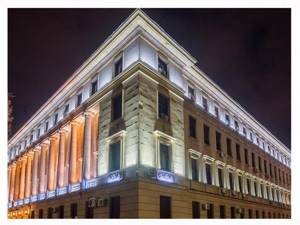
The technical side of the latter differs significantly from accent and contour lighting. Lamps for architectural flood lighting have high power and have a wide light dispersion angle in order to obtain uniform illumination of the entire façade of the building. The use of special lamps has its own placement rules, which in turn are dealt with by the lighting designer. Lamps are usually installed not on the building itself, but on the adjacent territory of the house, special poles or even neighboring buildings, and at the same time they have distinctive decorative elements that match the surrounding style. Office buildings, theaters, museums, rich mansions, private cottages - they are all great for flood lighting. Spot architectural lighting of a building
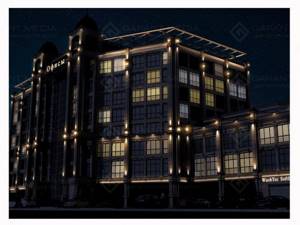
Spot architectural lighting of houses
used to highlight specific architectural details of a building's facade, columns, statues, unusual brickwork, significant exterior elements or small architectural forms in the surrounding area. As a rule, we use one glow color, this way we can achieve the natural color of one or another element and emphasize the architect’s idea. The whole point of spot lighting is that non-illuminated elements remain in the shadow, thereby not distracting attention from the main, illuminated elements. You can illuminate not only interesting design ideas of the facade, such as the use of heraldic signs, decorative elements or signs, but also emphasizing the elements surrounding the building - fountains, landscape elements and much more. Often local (spot) lighting of the facade of a house looks advantageous in combination with other types of lighting. It also lends itself perfectly to dynamics, with which you can set the flickering rhythm.
Our specialists will professionally approach the aesthetic and technical aspects of the issue. An important role will be played by the choice of the lamps themselves, which will meet all the requirements for safety, wear resistance, and will also be quite small in size in order to be as inconspicuous as possible. Save your time by leaving all technical issues to us and just enjoy the result.
Outdoor laser illumination of facades
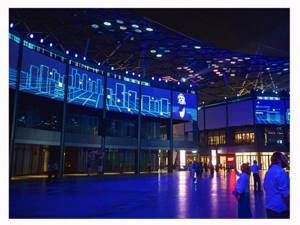
Modern lighting design technologies are constantly moving forward, today offering an experimental alternative to lighting using LEDs - laser home lighting. The advantage of such lighting is the number of effects achieved when using it, which are truly limitless. Laser illumination is capable of realizing any customer’s idea. The undeniable advantage of architectural laser lighting for a house is its relative cheapness, because it does not require laying light cords over a large area of the facade or installing a large number of lamps around the perimeter; the main load here is borne by the equipment. Thus, the classical approach to illumination of buildings is quite expensive and troublesome, while the use of a laser for illumination easily solves these problems, but on the other hand is not at all similar to other types of illumination, and will not achieve the same results, but essentially performs another function. The device itself is small in size, highly protected from moisture and dust, easy to install and capable of illuminating an area of up to 150 sq.m. In addition, the laser illumination is equipped with a control panel, with which you can select modes, as well as adjust the animation speed, control colors and effects, and adjust the lighting intensity. Due to its colorfulness and diversity, street laser lighting can be an excellent solution for New Year’s decoration of building facades. The price of laser illumination will satisfy any buyer. Lighting devices vary in size, configuration and functionality, so depending on your goals, you can choose lighting designed to suit any budget. Buying laser lighting means solving the problem of facade illumination - quickly, affordably and, most importantly, beautifully!
Equipment selection
Determining the configuration for decorative facade lighting depends on several parameters. These are the features of the building and the scale of the surrounding area. The following features determine the choice:
- Type of lamps used.
- Type of fastening.
- Installation features.
- Functional purpose.

Since the main task of outdoor lighting is to highlight the architectural beauty of the facade and illuminate the area around the building, it is very important to choose lighting fixtures with the necessary and most suitable technical characteristics for a particular object. This:
- Dustproof.
- Safety.
- Moisture resistance.
- Suitable for use in all weather and climatic conditions.
- Protection from mechanical impact.
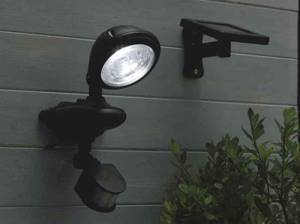
There are also several important points that you need to know and take into account when organizing architectural lighting for facades.
- The most reliable are lamps with an aluminum body. No less durable devices with housings made of acrylic or polycarbonate.
- Using fills of different colors allows you to better and more effectively highlight the protrusions and facades of the building.
- If you install lamps so that they illuminate the building from bottom to top, you can get an interesting effect.
- When installing LED façade lighting, it is imperative to install a transformer for power supply.
- It is best to use lamps that have IP65 protection for installation.

Types of architectural lamps
We have already said that developing a design project for a lighting system makes it possible to select the optimal types of lamps for each specific task. In this regard, there are a large number of lamps that are very different both in installation method and in the type of lamps used, which will allow you to realize the most extraordinary ideas.
- To organize external illumination of the facades of buildings of various purposes, adjacent or separate areas, advertising banners or billboards, architectural objects in the form of monuments or sculptures and even fountains, lamps in the form of solar-powered spotlights are often used;
- To create effective illumination of the contours of objects of complex configuration, for accent lighting of individual parts of facades or to create outdoor advertising, neon lighting is widely used;
- For illuminating tall objects, fluorescent lamps are the most profitable from an economic point of view;
- Lamps based on LEDs are very popular because they are economical and come in a variety of colors.
Depending on the installation method, luminaires can be designed as:
- Ground posts - LED or halogen;
- LED-based pendant lamps;
- Fixed wall sconces, which are used to illuminate a specific part of the facade;
- Built into open ground;
- Built into the facade of a building or other structure;
- Wall-mounted devices with the ability to adjust the angle of rotation and tilt of the light beam.
Lamps for architectural lighting
Architectural lighting and building lighting are designed using various lighting devices: spotlights, lanterns, strips, spot, accent, linear and other lamps. Taking into account the special operating conditions, all of them must meet several requirements:
- efficiency and environmental friendliness;
- ability to work regardless of climatic conditions;
- a sealed shell, usually in a vandal-proof design with a degree of protection no worse than IP65;
- high level of fire and electrical safety;
- ease of installation with a minimum of maintenance;
- housing made of durable material with increased resistance to corrosion.

